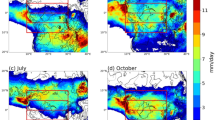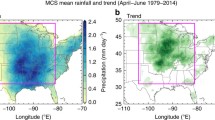Summary
The precipitation structure of mature Mesoscale Convective Systems (MCS) is examined in both the midlatitudes and the tropics using SSM/I microwave measurements, geostationary satellite observations, and ground-based radar observations. Discussion includes qualitative comparisons between midlatitude and tropical MCS cases, with particular emphasis on the delineation of convective and stratiform regions and the characterization of microwave polarization difference temperatures in the MCSs. Implications are given regarding the importance of the vertical precipitation structure on top of the atmosphere (TOA) microwave temperatures and for rain retrieval algorithms using measurements from space.
Some of the principle findings include the ability of passive microwave brightness temperature measurements to distinguish stratiform and convective regions of MCSs for both tropical and midlatitude cases and over land and ocean backgrounds. Convective regions typically had low differences between the vertical and horizontal brightness temperatures while the stratiform regions have larger differences, and these differences are likely related to the spatial microphysical variations in the upper levels of the precipitation region. Several cases were found in midlatitudes and one case in the tropics where the lowest infrared (IR) brightness temperatures were displaced into the anvil region and were not colocated with the coldest microwave temperatures. Life cycle dependence of the displacement is suggested, but the SSM/I measurements with a maximum of twice daily coverage over the same location were inadequate to answer this question.
Similar content being viewed by others
References
Adler, R., Negri, A. J., 1988: A satellite infrared technique to estimate tropical convective and stratiform rainfall.J. Appl. Meteor.,27, 280–296.
Alder, R., Mack, R., Prasad, N., Yeh, H., Hakkarinen, I., 1990: Aircraft microwave observations and simulations of deep convection from 18 to 183 GHz. Part I: Observations.J. Atmos. Oceanic Technol.,7, 377–391.
Evans, K. F., Vivekanandan, J., 1990: Multiparameter, radar and microwave radiative transfer modeling of nonspherical atmospheric ice particles.IEEE Trans. Geoscience and Rem. Sens.,28, 423–437.
Fritsch, J. M., Kane, R. J., Chelius, C. R., 1986: The contribution of mesoscale convective systems to the warmseason precipitation in the United States.J. Climate Appl. Meteor.,25, 1333–1345.
Fulton, R., Heymsfield, G. M., 1991: Microphysical and radiative characteristics of convective clouds during COHMEX.J. Atmos. Sci.,30, 98–116.
Grody, N. C. 1991: Classification of snow cover and precipitation using the Special Sensor Microwave Imager.J. Geophys. Res.,96, 7423–7435.
Grody, N. C., Ferraro, R. R., 1992: A comparison of passive microwave rainfall retrieval methods. Preprints,Sixth Conf. on Satellite Meteor. and Oceanography, Atlanta, G.A.: Amer. Metero. Soc., 60–65.
Hakkarinen, I. M., Adler, R. F., 1988: Observations of precipitating convective systems at 92 and 183 GHz. Aircraft results.Meteorl., Atmos. Phys.,38, 164–182.
Heymsfield, G. M., Blackmer, Jr., R. H., 1988: Satelliteobserved characteristics of Midwest severe thunderstorm anvils.Mon. Wea. Rev.,116, 2200–2224.
Heymsfield, G. M., Fulton, R., 1988: Comparison of high-altitude remote aircraft measurements with the radar structure of an Oklahoma thunderstorm: Implications for precipitation estimation from space.Mon. Wea. Rev.,116, 1157–1174.
Heymsfield, G. M., Fulton, R., 1992: Modulation of SMM/I microwave soil radiance by rainfall.Remote Sensing Environ.,39, 187–202.
Heymsfield, G. M., Parsons, C., Dod, L. R., Miller, L., 1989: Planned ER-2 Doppler radar (EDOP) for studying convective storms and mesoscale phenomena. Preprints,24th Conf. on Radar Meteorology. Tallahassee, FL: Amer. Meteor. Soc., 581–584.
Hollinger, J., Lo, R., Poe, G., Savage, R., Pierce, J., 1987:Special Sensor Microwave/Imager User's Guide. Washington, DC: Naval Research Laboratory, 120 pp.
Houze, R. A., 1977. Structure and dynamics of a tropical squall line-system.Mon. Wea. Rev.,105, 1540–1567.
Houze, R. A., 1982: Cloud clusters and large-scale vertical motions in the tropics.J. Meteor. Soc. Jpn.,60, 396–410.
Houze, R. A., 1987: Convective and stratiform precipitation in the tropics. In: Theon, J. S., Fugono, N. (eds.)Tropical Rainfall Measurements. Hampton, VA Deepak Publishing, 27–35.
Houze, R. A., Hobbs, P. V., 1982: Organization and structure of precipitating cloud systems.Adv. Geophys.,24, 225–315.
Houze, R. A., Smull, B. F., Dodge, P., 1990: Mesoscale organization of springtime rainstorms in Oklahoma.Mon. Wea. Rev.,118, 613–654.
Jackson, T. J., Schmugge, T. J., Wang, J. R., 1982: Passive microwave sensing of soil moisture under vegetation canopies.Water Resources Res.,18, 1137–1142.
Kummerow, C., Mack, R. A., Hakkarinen, I. M., 1989: A self-consistency approach to improve microwave rainfall estimation from space.J. Appl. Meteor.,28, 869–884.
Maddox, R. A., 1980: Mesoscale convective complexes.Bull. Amer. Meteor. Soc.,61, 1374–1387.
Martin, D. W., Suomi, V. E., 1972: A statellite study of cloud clusters, over the tropical North Atlantic Ocean.Bull. Amer. Meteor. Soc.,53, 135–156.
MacAnelly, R. L., Cotton, W. R., 1986: Meso-beta-scale characteristics of an episode of meso-alpha-scale convective complexes.Mon. Wea. Rev.,114, 1740–1770.
Miller, D., Fritsch, J. M., 1991: Mesoscale convective complexes in the western Pacific region.Mon. Wea. Rev.,119, 2978–2992.
Mugnai, A., Smith, E. A., 1988: Radiative transfer to space through a precipitating cloud at multiple microwave frequencies. Part I: Model description.J. Appl. Meteor.,27, 1055–1073.
Ogura, Y., Liou, M. T., 1980: The structure of a midlatitude squall line: a case study.J. Atmos. Sci.,37, 553–567.
Rutledge, S. A., Houze, Jr., R. A., Biggerstaff, M., Matejka, T., 1988: The Oklahoma-Kansas mesoscale convective system of 10–11 June 1985: Precipitation structure and single-Doppler radar analysis.Mon. Wea. Rev.,116, 1409–1430.
Rutledge, S. A., Williams E. R., Keenan, T. D., 1992: The down under doppler and electricity experiment (DUNDEE): Overview and preliminary results.Bull. Amer. Meteor. Soc.,73, 3–16.
Schmugge, T., Becker, F., 1991: Remote sensing observations for the monitoring of land-surface fluxes and water budgets. In: Schmugge, T., Andre, J. (eds.)Land Surface Evaporation: Measurement and Parameterization. Berlin, Heidelberg: Springer 337–347.
Simpson, J., Adler, R. F., North, G. R., 1988: A proposed Tropical Rainfall Measuring Mission (TRMM) satellite.Bull. Amer. Meteor. Soc.,69, 278–295.
Smith, E. A., Mugnai, A., 1988: Radiative transfer to space through a precipitating cloud at multiple microwave frequencies. Part II: Results and analysis.J. Appl. Meteor.,27, 1074–1091.
Spencer, R. W., 1986: A satellite 37GHz scattering-based method for measuring oceanic rain rates.J. Climate Appl. Meteor.,25, 754–766.
Spencer, R. W., Goodman, H. M., Hood, R. E., 1989: Precipitation retrieval over land and ocean with SSM/I: Identification and characteristics of the scattering signal.J. Atmos. Oceanic Technol.,6, 254–273.
Spencer, R. W., Olson, W. S., Rongzhang, W., Martin, D. W., Wienman, J. A., Santek, D. A., 1983: Heavy thunderstorms observed over land by the Nimbus 7 Scanning Multichannel Microwave Radiometer.J. Climate Appl. Meteor.,22, 1041–1046.
STORM, 1983:The National STORM Program: Scientific and Technological Bases and Major Objectives. University Corporation for Atmospheric Research, Boulder, 524 pp.
Wilheit, T., Chang, A., Rao, M., Rodgers, E., Theon, J., 1977: A satellite technique for quantitatively mapping rainfall rates over the oceans.J. Appl. Meteor.,16, 551–560.
Wilheit T., Chang, A., King, J. L., Rodgers, E. B., Nieman, R. A., Krupp, B. M., Milman, A. S., Stratigos, J. S., Siddalingaiah, H., 1982: Microwave radiometric observations near 19.35, 92, and 183 GHz of precipitation in tropical storm Cora.J. Appl. Meteor.,21, 1137–1145.
Yeh, H., Prasad, N., Mack, R., Adler, R., 1990: Aircraft microwave observations and simulations of deep convection from 18 to 183 GHz. Part II: Model results.J. Atmos. Oceanic Technol.,7, 392–410.
Zipser, E. J., 1988: The evolution of mesoscale convective systems: evidence from radar and satellite observations. In: Theon, J. S., Fugono N., (eds.)Tropical Rainfall Measurements. Hampton, Virginia, U.S.A.: Deepak Publishing, 159–166.
Author information
Authors and Affiliations
Additional information
With 10 Figures
Rights and permissions
About this article
Cite this article
Heymsfield, G.M., Fulton, R. Passive microwave and infrared structure of mesoscale convective systems. Meteorl. Atmos. Phys. 54, 123–139 (1994). https://doi.org/10.1007/BF01030055
Received:
Revised:
Issue Date:
DOI: https://doi.org/10.1007/BF01030055




